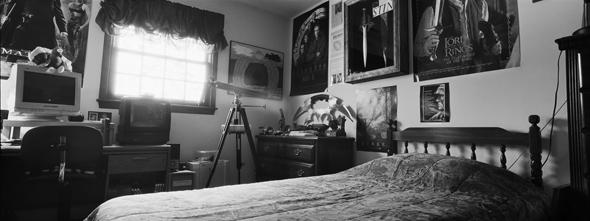
Army Private First Class Richard P. Langenbrunner, 19, killed himself on April 17, 2007, in Rustimayah, Iraq. He was from Fort Wayne, IN.(Ashley Gilbertson)
Ashley Gilbertson has made a small ceremony of stopping for a cup of coffee and a cigarette on his way to an assignment. One February morning in 2010, the scene of that ceremony was Earleville, MD, a farming town so tiny, and with so little demand for caffeine, it doesn’t have a coffee shop. Not even the gas station serves a steaming cup. So Gilbertson sat on a curb in front of the station and washed down his smoke with an energy drink, while some teenagers chased chickens around a pump.
It was a simple moment, but one that stayed with Gilbertson as he finished his cigarette and drove to the home of Brandon Craig. Gilbertson was on his way to photograph the Army corporal’s bedroom. Craig died in Husayniyah, Iraq, on July 19, 2007, blown up by a roadside bomb. He was 25. His room was small and clean. A stuffed raccoon rested against the pillows. A quilt in the shape of the American flag clung to one wall, the lyrics to “America the Beautiful” running along its white stripes.
In that room, and in the other bedrooms of soldiers killed in Iraq and Afghanistan Gilbertson has photographed, there is a stillness that is quieter than the streets of Earleville, and yet closer to the battlefield, too. “You can feel the war in Iraq and Afghanistan pressing against the walls in there,” says Gilbertson, a photojournalist who’s spent more than a decade chronicling the effects of that war. “And the kids chasing the chickens, and the family out front talking about how much they miss their son, all of a sudden that feels far away. I felt more like a war photographer in those bedrooms than I did in any moment in combat.”
That emotion is the force behind Bedrooms of the Fallen, a project Gilbertson has been working on for seven years, and which was published in June by the University of Chicago Press. After covering conflict throughout his career, and six long years in Iraq, Gilbertson had grown numb to the horrors of war. “One cadaver was indistinguishable from the next,” he writes in the book, “and worse still, they’d ceased to shock me.”
Bedrooms, though, are among our most intimate spaces. They are where we lay our heads; where we store our prizes and our memories; where we are most vulnerable. When they are left behind, bedrooms are like echoes of those who died.
The idea for Bedrooms began to take shape on November 15, 2004, while Gilbertson was on assignment in Fallujah. He was climbing the steps of a minaret, in which he had been told lay the body of an insurgent he was trying to photograph. A squad of marines escorted Gilbertson, led by lance corporals William Miller and Christian Dominguez. As they neared the top of the staircase, an enemy fighter shot Miller point-blank, splattering his blood over Gilbertson, who stood a few steps behind. “I was too much in shock to photograph Miller . . . ,” Gilbertson writes, “but if I had taken pictures, they would have depicted a crumpled, dying man. Those kinds of images show the horror and repugnance of war sure enough, and I’ve taken many of them. But they don’t speak to the larger truth: War takes people away from those who love them. I came home. So did Dominguez. Billy Miller didn’t. I needed to photograph his absence.”
Gilbertson sought this absence in photographing memorials and graves. But it eluded him. “That work is all about the living, about how they’re grieving,” he says. “My work was missing the central point that they were grieving over the absence of somebody. How do you shoot that absence?”
He found his answer in “the only space in the family house that is yours as a child.” Most of the bedrooms Gilbertson photographed reflect the average age of someone in the service, 21: Lord of the Rings posters and sound systems, barbells and stuffed animals.
Gilbertson only photographed rooms that were more or less untouched since their residents left. He contacted some 2,000 people, looking for families with undisturbed rooms who were open to the idea of Gilbertson photographing them. “I don’t believe in spirits or ghosts, or even god, but these rooms have so much power,” he says. “I refuse to touch anything in the room. I feel like in some ways I’m on an archaeological dig.”
The photographs have the sense of a moment preserved. There are rustled sheets, shirts tossed over furniture. In one, a dimpled duvet cover gives away the spot where Rifleman Paul Donnachie, 18, sat before heading off to war. The last bedroom in the book belongs to Army Specialist Ryan Yurchison, 27. It’s plastered in band posters and scattered with the toys of a young man–a Nixon mask, bobbleheads, drum sticks. Yurchison is the only service member in the book who made it home. But by the time he got there, he was suffering from post-traumatic stress disorder and an addiction to painkillers. He died of an overdose on May 22, 2010, in Youngstown, OH. “Ryan is the last person in the book because he made it home,” says Gilbertson, “but the war followed him.”
Christie Chisholm is a CJR senior editor. Follow her on Twitter at @c_chisholm.
